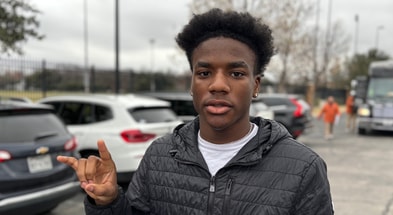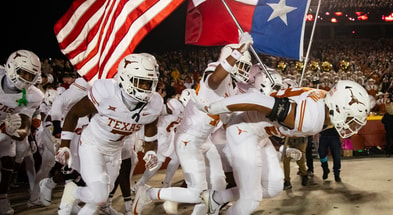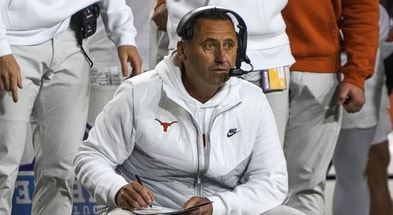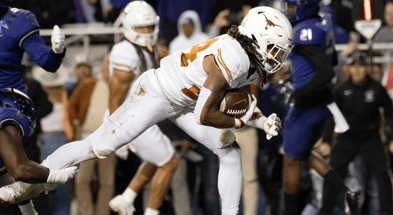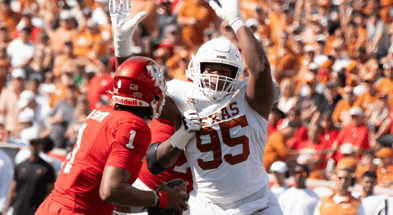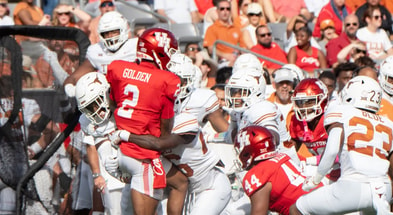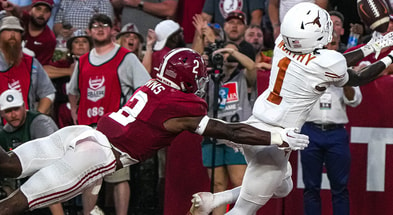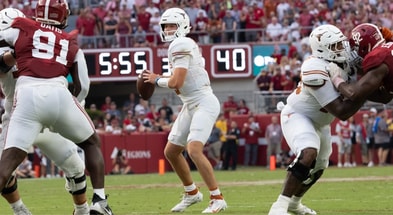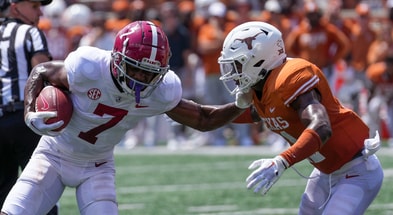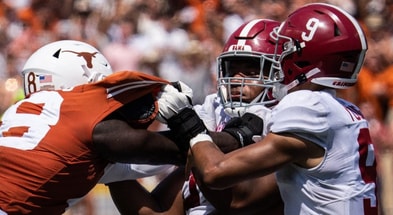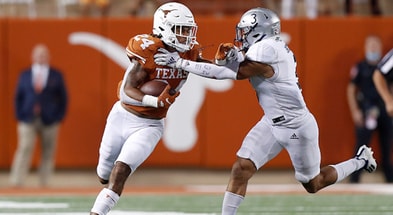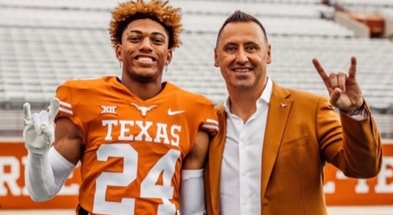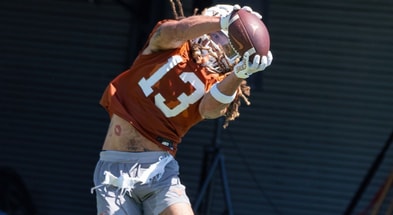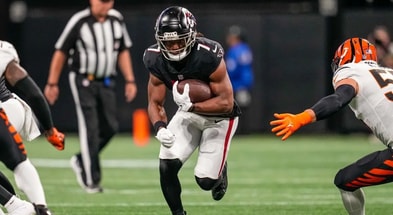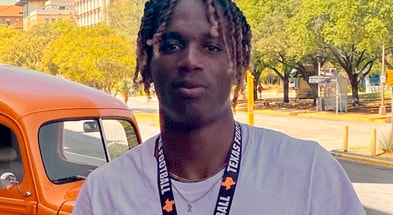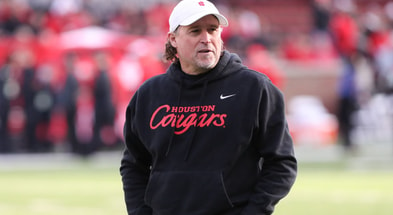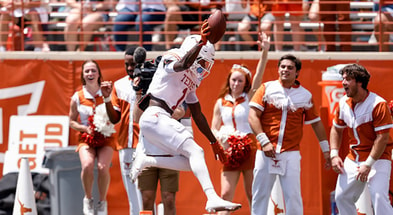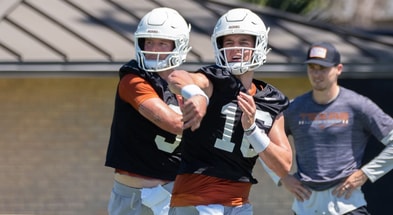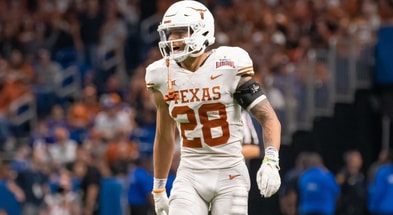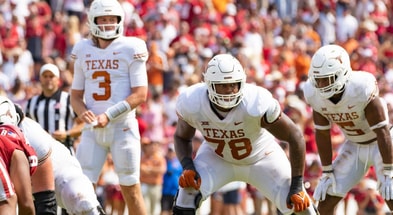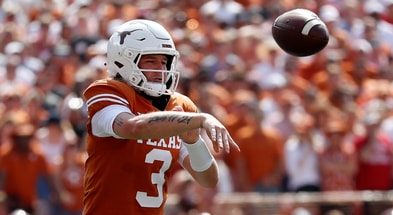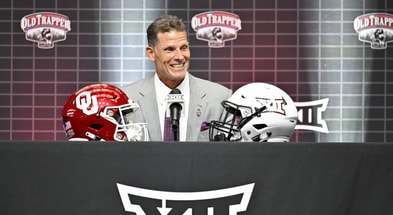2022 Texas vs. West Virginia Post Mortem: Defense & Special Teams

In the postgame press conference, Steve Sarkisian once again reiterated a message he’d mentioned twice coming into Saturday’s contest. Specifically, the need for the Longhorn defense to better match coverage to its pressure packages, a problem that was identifiable against UTSA and proved deadly against Texas Tech. The defensive brain trust appeared very much on board with an early game plan that challenged West Virginia’s favorite spots and timing in the passing game.
[Get ONE MONTH of Inside Texas Plus for $1!]
Were some of West Virginia’s early drops the result of Texas defenders distorting timing or JT Daniels getting off a less than ideal ball due to pressure and different looks? More crucially, was the outstanding energy from the Texas defense attributable in any way to a game plan that fostered early success through aggression and disruption? Sometimes taking the fight to the enemy and not offering them an easy escape valve underneath has intangible benefits that filter through the entire defense. You could see it with the quality of hitting and gang tackling on Saturday. Defense is largely mindset. Some game plans nourish the right one.
It also helped that JT Daniels is a statue and Texas didn’t have to fret over opportunistic QB runs. Texas also played several different fronts, including more use of three interior defensive linemen at once, some true 3-3-5 looks and far fewer defensive back blitzes (where Daniels could just throw to vacated space) and many more interior and linebacker pressure combos. That’s the right direction. Nickel and corner blitzes should be high leverage surprises. Not staples.
The Mountaineers had only nine possessions on Saturday. The Texas defense dominated the first five of them, holding West Virginia to 75 yards on 26 plays with four punts and a crucial turnover on downs near midfield. Combined with a red hot Longhorn offense, that staked Texas to leads of 28-0 and 35-7 which West Virginia eventually chipped away at by scoring touchdowns on three of their last four drives. Some of that was attributable to solid Mountaineer adjustments and playmaking, but the officials helped bolster some West Virginia drives with a Jamison personal foul called on a Sam James soccer flop and an absurd T’Vondre Sweat roughing call where he was found guilty of playing football.
Overall, Texas held West Virginia to 20 points and only 314 yards on 78 plays. A less than robust 4 yards per play average (Texas averaged 7.4). West Virginia only averaged 8.7 yards per completion (Hudson Card averaged over 11 per attempt) and though they ended up doing well on money downs, it was largely back loaded to the final quarter of play. West Virginia was 0-3 on 3rd and 4th down on their first two drives.
DL
Outstanding game overall. Texas started Sweat and Coburn together which created different pairings and rotations throughout the game that I favored. Texas ran some different fronts and Neal Brown remarked in his postgame that some of the looks took West Virginia by surprise. While Texas only notched 3 sacks overall, pressure on Daniels was consistently good for long stretches and they frequently knocked him off of his spot. Sorrell had several good pass rushes (1.5 sacks, another QB hit, 2 pressures) and Oghoufo wasn’t found too far upfield even once. Prince Dorbah got a number of snaps and I was going to praise him for coming flat in backside pursuit to notch a tackle for loss like he was Joseph Ossai, but my praise was wiped out when he lined up in the neutral zone on the same possession on a 3rd and 8. Prince had 4 tackles overall.
West Virginia totaled only 61 rushing yards and they were resigned to the short passing game to move the ball. A big chunk of that is because of the Texas front winning. Byron Murphy’s box score says only 3 tackles and 1 tackle for loss, but he was consistently terrific and should have drawn two holding calls. Sweat had some impact plays, including a big run stuff that another Longhorn cleaned up, a big hit on Daniels (erroneously flagged) and a tipped ball, but the box score shows zero tackles. In a similar vein, Ojomo had some good motor plays that didn’t show up in the game tally beyond his sack.
Top 10
- 1New
Arkansas upsets Kentucky
Cal wins in Rupp return
- 2
Reed Sheppard
Shows support for John Calipari
- 3
Tampering concerns
Nebraska likely to cancel spring game
- 4
Caleb Love headbutted
Multiple ejections in Arizona
- 5Hot
Bobby Hurley
Refuses handshake line
Get the On3 Top 10 to your inbox every morning
By clicking "Subscribe to Newsletter", I agree to On3's Privacy Notice, Terms, and use of my personal information described therein.
LB
Jaylan Ford notched 14 tackles and did a nice job flowing to the ball throughout. The disposition of the Texas front and the overall defense allowed Overshown to play free agent all over the field and he notched 8 tackles and pursued well for four quarters. He’s not always sure what he’s doing in the passing game and it would be useful if Texas could do more than just delay blitz him. He has the ability to drop into a route break and get a pick. Tucker-Dorsey got some play in three linebacker packages, but Texas is starting to hone in on Ford and Overshown as our ride-or-die guys on the second level.
DB
The Longhorns had a season high 7 pass breaks ups, led by Jamison’s 2. Jamison had a good game, even as WVU sought to target him early with Bryce Ford-Wheaton. Eventually, they moved their attention elsewhere. Coming into West Virginia, Texas had totaled 12 PBU in four previous contests. Were the increased pass break ups and Daniels’ 56% halftime completion percentage (14 of 25 for 142 yards) a function of more challenged routes and better up front pressure? It sure looked like it.
Jerrin Thompson had ten tackles and a pass break up. Anthony Cook had only four tackles, but I heard and felt all four of them. Solid games from both and it was nice to see them doing a bit more than just play two deep. Ryan Watts continues to tackle and run support well. Jahdae Barron had a preventable pass interference and I’d like to see him jump a slant soon. This group played winning football overall. West Virginia’s longest pass play was a 32 yard back shoulder fade to Ford-Wheaton on a perfect throw and Daniels averaged a measly 5.3 yards per attempt. A more aggressive game plan in terms of attacking routes early rather than conceding “harmless throws” seemed to suit this bunch well. Overall cohesion was good.
Special Teams
Texas only punted twice, but Trejo’s first effort wasn’t good. Sideshow Bert Auburn drilled a 40+ yarder and is now a perfect 6 of 6 on field goals between 40-49 yards on the season and 10 of 12 overall. If you thought field goal kicker would be a season strength, raise your hand. West Virginia ran a great onside kick late that Texas was lucky to recover.
Final
Texas didn’t have a good game plan for a limited offense in Texas Tech last week. This week, Texas had a good game plan for a somewhat limited West Virginia offense. The difference was written all over the field and the scoreboard. And in the locker room…

